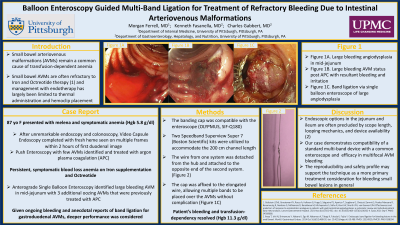Tuesday Poster Session
Category: GI Bleeding
P3514 - Balloon Enteroscopy Guided Multi-Band Ligation for Treatment of Refractory Bleeding Due to Intestinal Arteriovenous Malformations
Tuesday, October 24, 2023
10:30 AM - 4:00 PM PT
Location: Exhibit Hall

Has Audio

Morgan Ferrell, MD
University of Pittsburgh Medical Center
Pittsburgh, PA
Presenting Author(s)
Morgan Ferrell, MD, Kenneth Fasanella, MD, Charles Gabbert, MD
University of Pittsburgh Medical Center, Pittsburgh, PA
Introduction: Small bowel arteriovenous malformations (AVMs) remain a common cause of transfusion-dependent anemia. Often refractory to iron and octreotide, management with endotherapy has largely been limited to thermal administration and hemoclip placement. In our case, modification of an everyday device allowed for targeted multi-band ligation via single balloon enteroscopy, providing an effective adjunct therapy for bleeding from intestinal AVMs.
Case Description/Methods: 87-year-old female presented with melena and symptomatic anemia (hemoglobin 5.8 g/dl). Initial endoscopic evaluation was unrevealing, thus video capsule endoscopy was performed. Fresh heme was seen on multiple frames, all within two hours of the first duodenal image. Subsequent push enteroscopy localized few AVMs that were treated with argon plasma coagulation (APC). Persistent blood loss anemia led to its repeat performance, where AVMs were again treated with APC and hemoclips. Iron and octreotide were initiated in the interim. Due to ongoing bleeding, we then decided to perform anterograde single balloon enteroscopy. A large bleeding angiodysplasia was seen in the mid-jejunum (Figure 1A), along with three oozing AVMs upstream (one with overlying clip). APC was applied to the large lesion yet led to further bleeding and irritation (Figure 1B). Given anecdotal reports of band ligation for gastroduodenal AVMs, deeper performance thereof was considered. The banding cap was compatible with the enteroscope (OLYMPUS, SIF-Q180). To accommodate the 200 cm channel length, two Speedband Superview Super 7 (BOSTON SCIENTIFIC) kits were utilized. The wire from one system was detached from the hub and attached to the opposite end of a second system by a loop-within-loop pull method. The cap was affixed to the elongated wire, allowing multiple bands to be placed over the AVMs without complication (Figure 1C). Her bleeding and transfusion-dependency resolved, as hemoglobin returned to baseline (11.3 g/dl).
Discussion: Vascular lesions of the small bowel warrant further strategies for effective management. Endoscopic options in the jejunum and ileum are often precluded by scope length, looping mechanics, and device availability. Our case is unique in that it reports compatibility of a standard multi-band device with a common enteroscope, along with efficacy in multifocal AVM bleeding. Furthermore, its reproducibility and safety profile may support the technique as a more primary treatment consideration for bleeding small bowel lesions in general.

Disclosures:
Morgan Ferrell, MD, Kenneth Fasanella, MD, Charles Gabbert, MD. P3514 - Balloon Enteroscopy Guided Multi-Band Ligation for Treatment of Refractory Bleeding Due to Intestinal Arteriovenous Malformations, ACG 2023 Annual Scientific Meeting Abstracts. Vancouver, BC, Canada: American College of Gastroenterology.
University of Pittsburgh Medical Center, Pittsburgh, PA
Introduction: Small bowel arteriovenous malformations (AVMs) remain a common cause of transfusion-dependent anemia. Often refractory to iron and octreotide, management with endotherapy has largely been limited to thermal administration and hemoclip placement. In our case, modification of an everyday device allowed for targeted multi-band ligation via single balloon enteroscopy, providing an effective adjunct therapy for bleeding from intestinal AVMs.
Case Description/Methods: 87-year-old female presented with melena and symptomatic anemia (hemoglobin 5.8 g/dl). Initial endoscopic evaluation was unrevealing, thus video capsule endoscopy was performed. Fresh heme was seen on multiple frames, all within two hours of the first duodenal image. Subsequent push enteroscopy localized few AVMs that were treated with argon plasma coagulation (APC). Persistent blood loss anemia led to its repeat performance, where AVMs were again treated with APC and hemoclips. Iron and octreotide were initiated in the interim. Due to ongoing bleeding, we then decided to perform anterograde single balloon enteroscopy. A large bleeding angiodysplasia was seen in the mid-jejunum (Figure 1A), along with three oozing AVMs upstream (one with overlying clip). APC was applied to the large lesion yet led to further bleeding and irritation (Figure 1B). Given anecdotal reports of band ligation for gastroduodenal AVMs, deeper performance thereof was considered. The banding cap was compatible with the enteroscope (OLYMPUS, SIF-Q180). To accommodate the 200 cm channel length, two Speedband Superview Super 7 (BOSTON SCIENTIFIC) kits were utilized. The wire from one system was detached from the hub and attached to the opposite end of a second system by a loop-within-loop pull method. The cap was affixed to the elongated wire, allowing multiple bands to be placed over the AVMs without complication (Figure 1C). Her bleeding and transfusion-dependency resolved, as hemoglobin returned to baseline (11.3 g/dl).
Discussion: Vascular lesions of the small bowel warrant further strategies for effective management. Endoscopic options in the jejunum and ileum are often precluded by scope length, looping mechanics, and device availability. Our case is unique in that it reports compatibility of a standard multi-band device with a common enteroscope, along with efficacy in multifocal AVM bleeding. Furthermore, its reproducibility and safety profile may support the technique as a more primary treatment consideration for bleeding small bowel lesions in general.

Figure: Figure 1A. Large bleeding angiodysplasia within the mid-jejunum
Figure 1B. Large angiodysplasia status post APC with resultant oozing and mucosal irritation
Figure 1C. Band ligation via single balloon enteroscope of large angiodysplasia
Figure 1B. Large angiodysplasia status post APC with resultant oozing and mucosal irritation
Figure 1C. Band ligation via single balloon enteroscope of large angiodysplasia
Disclosures:
Morgan Ferrell indicated no relevant financial relationships.
Kenneth Fasanella indicated no relevant financial relationships.
Charles Gabbert indicated no relevant financial relationships.
Morgan Ferrell, MD, Kenneth Fasanella, MD, Charles Gabbert, MD. P3514 - Balloon Enteroscopy Guided Multi-Band Ligation for Treatment of Refractory Bleeding Due to Intestinal Arteriovenous Malformations, ACG 2023 Annual Scientific Meeting Abstracts. Vancouver, BC, Canada: American College of Gastroenterology.

